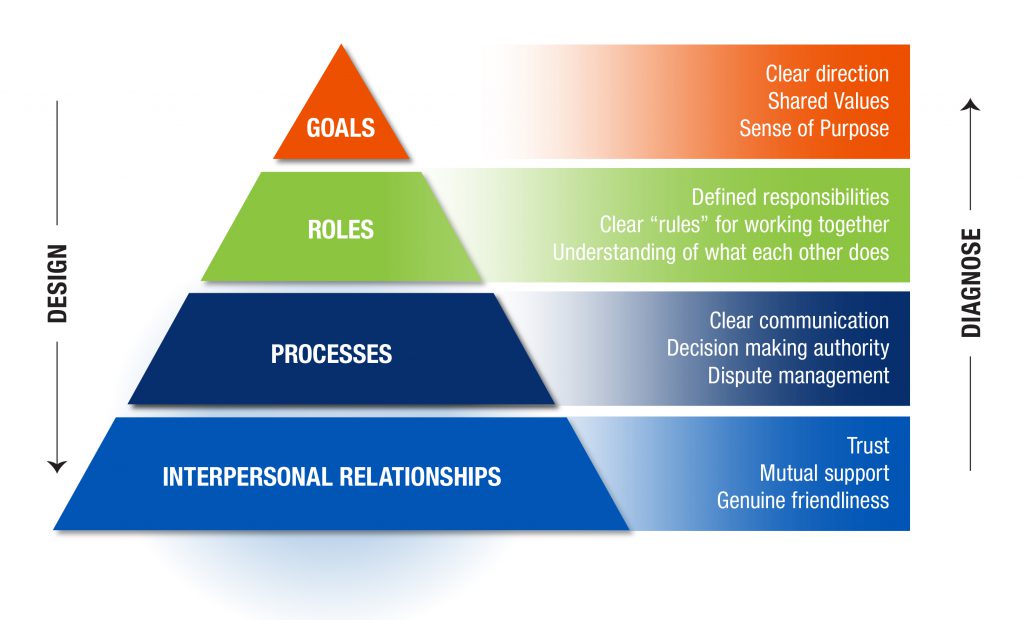- February 8, 2023
- Posted by: Craig Martin
- Category: Leadership

Dysfunctional is not a characteristic any leader wants to use when describing their organization or team. But with various skill sets, experiences, and personalities at play, organizational dysfunction is inevitable without the right structure for operational success. If you are searching for a method to implement that will equip your leaders to build high-performing, functional teams, the GRPI Model can optimize performance and help teams get back on track if their collaboration and processes have broken down.
At Martin Global Leaders, we leverage this framework to help CEOs, executives, and team leaders investigate interpersonal conflicts, operational dysfunction, or issues within an organizational structure by getting to the root cause of problems in a systemic way.
About the GRPI Model
GRPI (pronounced “grippy”) is an acronym for Goals, Roles, Processes, and Interpersonal Relationships, developed by organizational theorists Richard Beckhard and Reuben Harris (1977). This framework helps executives and top leaders clarify a team or organization’s purpose, set priorities, increase efficiency, and identify and prevent problems. Working top-down from Goals, GRPI can be used for designing an effective structure of a team or organization. Working bottom-up using our GRPI checklist (available for download), it helps diagnose the root cause of interpersonal conflict and poor results. As a result, leaders and teams can more rapidly improve their teamwork and results.

GRPI Case Study
Often, we hear top leaders complain about interpersonal conflict and other “noise in the system” that consumes a vast amount of their time and energy, polluting their organization with negativity. This is typically ascribed to the people involved without really asking the question, “how did we get here?” And as humans, we tend to personalize conflict and assume bad intentions about the other person, leading to blame, recrimination, and worse. However, the real answer is usually that such conflict is a byproduct of lack of clarity about goals, misaligned roles, and ineffective processes. Left unattended, these issues can metastasize into interpersonal rifts between individuals or even whole departments, distracting the organization from growth and innovation.
A real case to show how this can unfold:
Client Problem: A small software company needed the MGL team to help navigate a dispute that started between two department leaders and negatively impacted the entire organization. These two department leaders were at each other’s throats after a decision made by the executive team to restructure two revenue-producing teams and move some members from one department to another.
MGL Diagnosis: The assignment changes were made without fully planning how to share credit for revenue between the two teams. Some members were “loyal” to their old leader and didn’t want to move departments. One of the leaders felt their resources were being eroded, making their department less able to deliver on their revenue targets for the company. This resulted in conflict and power struggles. It started to affect team members as their loyalty began to come into question, and there needed to be more clarity around compensation.
MGL Solution: Instead of focusing solely on these leaders’ interpersonal relationships, we focused on the systemic factors that contributed to the problems. Just addressing the interpersonal relationships would still leave the breakdown in processes and role clarity unattended. This model diagnosed how things went array in this organizational structure and gave the executive team a chance to view the dysfunctional dispute not as the “source” of the problem but as the symptoms of a deeper problem. Realigning sales targets (Goals), department resources (Roles), and revenue tracking (Processes) were the answer.
Is your organization facing any of these challenges?
- Is there an interpersonal conflict between two or more leadership team members?
- Is there a chronic lack of alignment on strategy?
- Does the CEO feel their job is to mediate conflicts rather than look at future strategies?
- Do leaders feel their energy is drained or depleting and consider rebuilding a team altogether?
- Is there a lack of consistency in meeting goals?
- Not getting synergy out of a team and only seeing basic levels of work?
- Do leaders spend time chasing down miscommunication, “who said what,” and finger-pointing instead of investing time in new solutions?
- Are team members focused on the past and present rather than where the company is going?
If any of these issues need to be addressed in your organization, please contact Martin Global Leaders at [email protected] to request a free 30-minute consultation. Get a copy of our GRPI checklist. Learn more about our Systemic Team Coaching.

